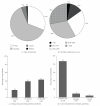A survey of perioperative and postoperative anesthetic practices for cesarean delivery
- PMID: 21217809
- PMCID: PMC2915619
- DOI: 10.1155/2009/510642
A survey of perioperative and postoperative anesthetic practices for cesarean delivery
Abstract
The aim of this survey was to review cesarean delivery anesthetic practices. An online survey was sent to members of the Society of Obstetric Anesthesia and Perinatology (SOAP). The mode of anesthesia, preferred neuraxial local anesthetic and opioid agents, postoperative analgesic regimens, and monitoring modalities were assessed. 384 responses from 1,081 online survey requests were received (response rate = 36%). Spinal anesthesia is most commonly used for elective cesarean delivery (85% respondents), with 90% of these respondents preferring hyperbaric bupivacaine 0.75%. 79% used intrathecal fentanyl and 77% used morphine (median [range] dose 200 mcg [50-400]). 91% use respiratory rate, 61% use sedation scores, and 30% use pulse oximetry to monitor for postoperative respiratory depression after administration of neuraxial opioids. Postoperative analgesic regimens include: nonsteroidal anti-inflammatory agents, acetaminophen, oxycodone, and hydrocodone by 81%, 45%, 25%, and 27% respondents respectively. The majority of respondents use spinal anesthesia and neuraxial opioids for cesarean delivery anesthesia. There is marked variability in practices for monitoring respiratory depression postdelivery and for providing postoperative analgesia. These results may not be indicative of overall practice in the United States due to the select group of anesthesiologists surveyed and the low response rate.
Figures




References
-
- Martin JA, Hamilton BE, Sutton PD, et al. Births: final data for 2005. National Vital Statistics Reports. 2007;56(6):1–103. - PubMed
-
- Carvalho B, Roland LM, Chu LF, Campitelli VA, III, Riley ET. Single-dose, extended-release epidural morphine (DepoDur) compared to conventional epidural morphine for post-Cesarean pain. Anesthesia and Analgesia. 2007;105(1):176–183. - PubMed
-
- Stamer UM, Wiese R, Stuber F, Wulf H, Meuser T. Change in anaesthetic practice for Caesarean section in Germany. Acta Anaesthesiologica Scandinavica. 2005;49(2):170–176. - PubMed
-
- Van Houwe P, Heytens L, Vercruysse P. A survey of obstetric an anaesthesia practice in Flanders. Acta Anaesthesiologica Belgica. 2006;57(1):29–37. - PubMed
-
- Chan YK, Ng KP. A survey of the current practice of obstetric anaesthesia and analgesia in Malaysia. Journal of Obstetrics and Gynaecology Research. 2000;26(2):137–140. - PubMed
LinkOut - more resources
Full Text Sources

